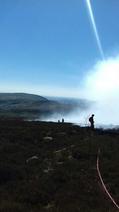The Peak District National Park Authority has implemented Operation FireWatch in collaboration with the Moors for the Future Partnership.
Staff from the National Park, partner organisations and volunteers are in place at moorland vantage points throughout the National Park to look out for fires.
The hot, dry weather means that ground conditions on the moors are extremely dry and the risk of fire is high.
Residents and visitors are asked to be extra vigilant to help prevent moorland and grassland fires.

Sarah Fowler, chief executive of the Peak District National Park Authority, said: “With the hot weather set to continue over the next few days, the risk of further fires is a real concern.
“We have implemented Operation FireWatch to keep a close eye on conditions on the moorlands and we are urging everyone to get involved by doing everything they can to help prevent fires starting.
“We have put fire risk warning notices at moorland access points to remind everyone of the dangers but we need people enjoying the moors to observe a few basic rules:
“Leave your barbecues and fire-pits at home. Don’t drop cigarette ends or matches. Take glass bottles and litter home with you. Don’t light fires or barbecues on or near moorland. Report fires immediately to the fire service by phoning 999.”
Fire-fighters have been tackling an extensive moorland fire in the north-west of the National Park, near Stalybridge, Tameside, since Monday (25 June) – some 2,000 hectares of moorland habitat has been destroyed. Working with fire-fighting team and other partners and moorland managers, the National Park Authority is providing staff, vehicles, supplementary equipment, logistics support and local access expertise in the hard to reach places.
Sarah Fowler added: “As we have already seen this week at Tameside, in these dry conditions moorland fires spread very quickly and are devastating to the landscape, lethal for wildlife and a threat to people and homes.
“It’s breeding season for nature at this time of year on the moorlands; we have birds nesting on the ground – plover, curlew and lapwing, insects such as the bilberry bumblebee, mountain hare and other mammals, and reptiles like the tiny common lizard. Many of these species are rare or under threat – it’s vital that we all do what we can to protect them and prevent any more fires breaking out.”
The fire at Tameside is the third moorland fire in the Peak District National Park in 2018. In May, around 40 hectares of moorland were destroyed at the Goyt Valley and five hectares of moorland were damaged by fire at Big Moor, near Baslow.
The Peak District National Park Authority and Moors for the Future Partnership are working closely together with partners, including moorland owners and managers, to assess the long-term risk of wildfires on the moors as part of a shared long-term vision for resilient, sustainable moorlands in the National Park.